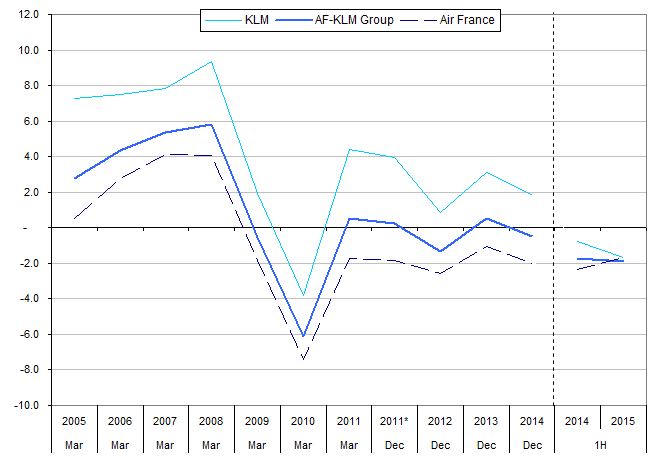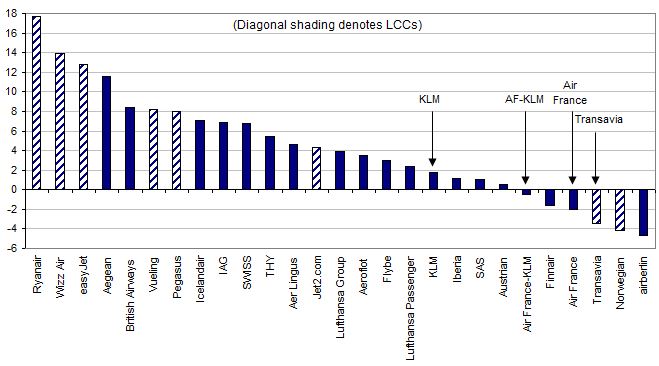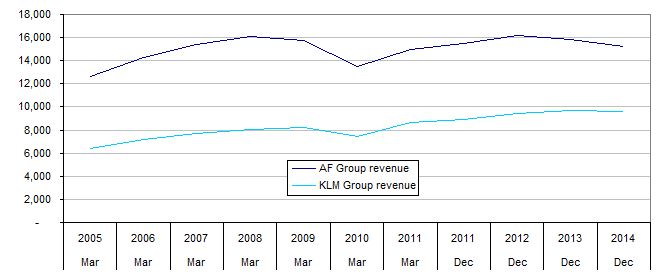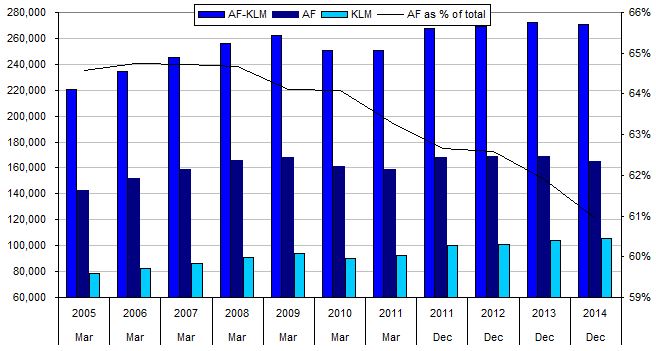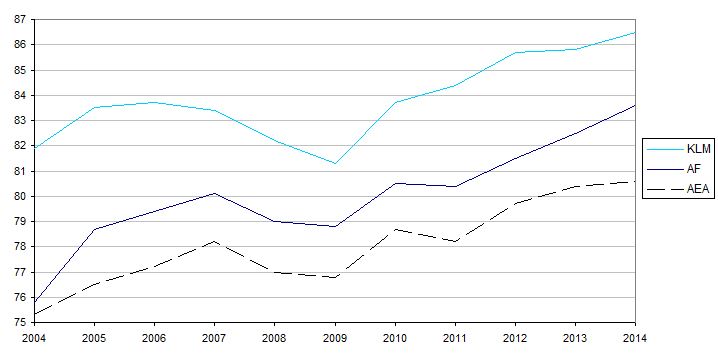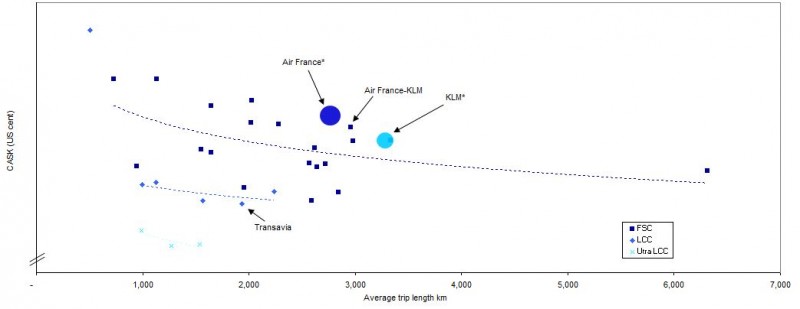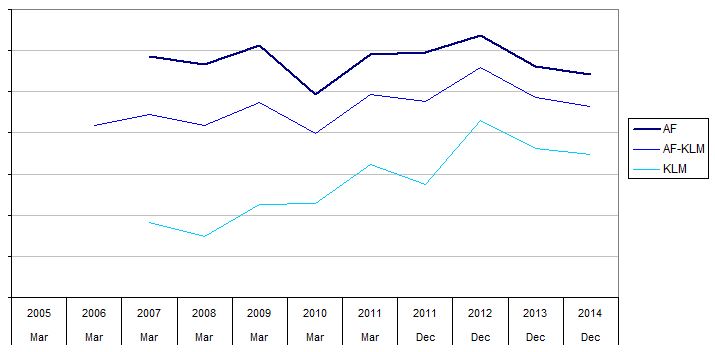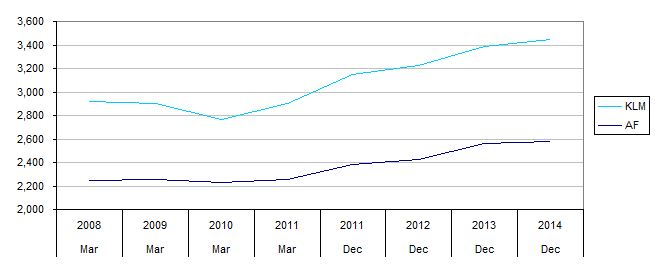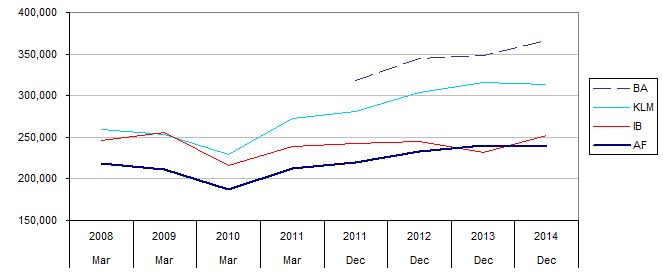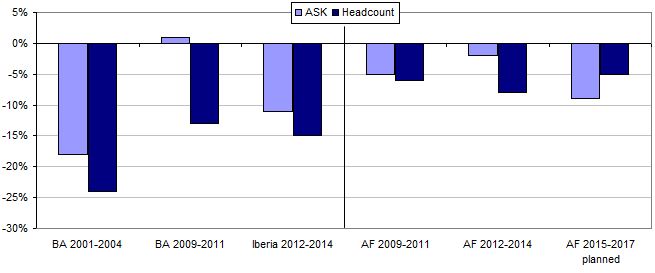Air France: Seven years of losses before Works Council clash reveals a cracked mirror
Jumping from specialist media and the business pages, Air France's struggle to restore profits by confronting industrial relations issues has received the attention of global mainstream media. Images of Air France managers stripped of the shirts have been seen across the world.
Air France failed to agree with flight crew unions on improved labour productivity by its self-imposed deadline of 30-Sep-2015. As a result, it decided to implement its alternative plan of cutting back on long haul operations and staff numbers. Although the employees that attacked management presenting the plan to the Works Council may not be fully representative of the Air France workforce, the episode holds up a mirror to both labour and management.
The mirror is cracked and Air France has had seven years of losses. It does not report separate results, but CAPA has pieced together an analysis of Air France's financial performance since the KLM merger in 2004. Its margins have been below KLM's throughout and also lag other European airlines. At the heart of its problem is low labour productivity. Improvements in this area will be vital to a sustainable future for Air France.
No analysis of Air France profitability since the KLM merger
The Air France-KLM Group only started publishing separate revenue and operating profit figures for both of its major subsidiaries in 2014, when it also published 2013 data. This means that precise financial results for Air France are not available for years prior to 2013. However, in this report, we attempt to perform this analysis on Air France. KLM has published its own annual report every year and so the cycle of KLM's operating profit margin is transparent. We have previously analysed KLM's performance since the merger using these results.
See related report: KLM: a decade after Air France merger, the smaller, but more profitable partner also needs cost cuts
An approximation of Air France's operating margin before 2013 can be derived from the Air France-KLM and KLM results (by subtracting KLM's revenue and operating profit figures from those of Air France-KLM). Although Group accounting means that the results of the two subsidiaries do not always add up to give the Group result, this method should give a useful broad indication of how Air France has performed since the merger with KLM.
Air France: seven years of operating losses, always less profitable than KLM
Using this approach, we can deduce that Air France has not made a positive operating result since the financial year ended Mar-2008, before the global financial crisis. Even then, its peak margin of 4.1% compared unfavourably with KLM's 9.4% and the Air France-KLM Group's 5.8%. Since then, Air France has endured seven successive financial years of red ink, accumulating EUR2.7 billion of operating losses.
Furthermore, ever since the merger, Air France's operating margin has consistently been 3-6ppts below that of KLM. Its Dutch sister company fell into an operating loss in just one financial year, to Mar-2010, but has recorded a positive result every year since then. Both airlines suffered a decline in margin in 2014, but KLM's 1.8% remained significantly ahead of Air France's -2.0%.
Air France's 2014 result, which followed its best post crisis margin of -1.1% in 2013, was adversely affected by a pilot strike. Without the strike, the company estimated that it would have recorded a positive operating result, with an operating margin that we calculate at 0.7%.
Nevertheless, this would still have been a wafer thin margin five years into the post crisis recovery period, when the industry globally was starting to approach previous peak margin levels. Moreover, Air France's 2014 margin ranks it among the very worst performing airlines among the Stock Exchange-listed European airline groups and their subsidiaries.
Annual operating margin (% of revenue) for Air France Group**, KLM Group and Air France-KLM Group: FY2005 to 2014, 1H2014 and 1H2015
Operating margins* for listed European airline companies and their principal subsidiaries (Air France-KLM companies highlighted): 2014
2015 is looking a little better
Results for 1H2015, traditionally the loss-making half year, gave cause for a little more optimism on the part of Air France, which narrowed its margin of loss to -1.7% from -2.4% a year earlier. In doing so, Air France equalled the 1H2015 performance of KLM, whose margin fell to -1.7% from -0.7% in 1H2014. However, KLM's result was adversely affected by increased pension related costs and the weak first half typically is not a reliable indicator of full year performance.
Air France CEO Frédéric Gagey has said that operating margin will be positive in 2015, as per a Reuters report from 08-Oct-2015. This looks possible after the 1H result, but the margin is unlikely to be significantly positive. For the Air France-KLM Group as a whole, analysts are currently forecasting an operating margin of a little more than 1%.
If Air France can exceed this group margin, it will be the first time that it has been more profitable than KLM. Either way, such low single digit margins compare poorly with CAPA's forecast that the global airline industry in aggregate will approach previous cyclical peak operating margins in 2015 (and industry peak margins of around 6% are themselves fairly slim). IAG, Europe's most profitable legacy airline group, is forecast by analysts to make a 10% margin in 2015.
Of course, it is to be welcomed that Air France is on an improving margin path, but an airline that is scraping back into profitability when the industry is enjoying historically high margins still has a long way to go.
Air France revenue hit harder than KLM's in recession, remains below pre-crisis level
At the time of the Air France merger with KLM in 2004, the French airline group's revenue was roughly double that of its Dutch sister. This ratio of their revenues continued until the global financial crisis, which hit Air France's revenue more heavily than KLM's.
Air France's revenue started to fall in the year to Mar-2009 (decline of 2%), even though its capacity was still growing modestly. In the year to Mar-2010, Air France suffered a 14% revenue collapse, compared with a 9% drop for KLM. Air France just surpassed its pre-crisis peak revenue of EUR16.1 billion in 2012, but this then declined again to a level of EUR15.3 billion in 2014, below where it had been in FY2007.
(Note that Air France-KLM's financial year end changed from Mar to Dec in 2011; in this report, references to financial years before the change include the letters 'FY', while financial years after the change coincide with calendar years.)
By contrast, KLM comfortably surpassed its pre-crisis peak revenue of EUR8.2 billion (achieved in FY2009) in FY2011 and continued to grow every year until 2013, when it fell by 0.5% to a level of EUR9.6 billion in 2014. Air France's revenue, 100% greater than KLM's before the crisis, was only 62% bigger in 2014.
Annual revenue for Air France Group* and KLM Group: FY2005 to 2014
Air France's share of AF-KLM capacity is falling
Neither Air France nor the Air France-KLM Group report separate traffic or capacity data for the French airline. However, KLM reports its annual traffic data in its own annual report and we can estimate Air France capacity (available seat kilometres (ASKs)) by deducting the KLM figures from the Air France-KLM Group figures.
In the first years after the merger, both Air France and KLM increased ASKs at similar rates of around 4% to 6%. Air France's ASK growth rate slowed down to around 1% in FY2009 (although revenue had already started to fall by then), while KLM continued at 4%, and both cut ASKs by 4% in FY2010. The much heavier fall in revenue suffered by Air France in the crisis, described above, displays the greater sensitivity of its unit revenue to the demand environment.
Air France recovered to its FY2009 ASK level in 2011 (calendar year), but has seen little further capacity growth since then. Indeed, Air France reduced ASKs by 2% in 2014, largely as a result of flights lost to pilot strikes. In 2014, Air France's ASKs were still below their FY2008 level. KLM more than recovered its FY2009 level in 2011 and had increased its ASKs by a further 6% by 2014.
As a result of their different growth rates, Air France's share of Air France-KLM Group ASKs fell from almost 65% in the years before the crisis to 61% in 2014.
Available seat kilometres (ASK, million) for Air France Group*, KLM Group and Air France-KLM Group: FY2005 to 2014
Air France has healthy load factor, but KLM's is higher
One of Air France's strongest performance indicators is its passenger load factor. According to data from AEA S.T.A.R. 2015 (the statistical publication of the Association of European Airlines), Air France's passenger load factor gained 7.8ppts in the first decade after its merger with KLM.
Its 2014 load factor of 83.6% was the third highest in the AEA and its ten year improvement was more than the 4.6ppt gain experienced by KLM. Nevertheless, KLM's 2014 load factor of 86.5% was still 2.9ppts above that of its French sister airline and was the highest in the AEA (SWISS was second at 83.7%).
Passenger load factor for Air France, KLM and Association of European Airlines: 2004 to 2014
Air France has cut short/medium haul and grown long haul since the crisis
Air France's ASKs fell slightly (around 2%) in 2014, the result of the pilot strike, but its capacity has recovered modestly from FY2011, which marked its lowest point after the global financial crisis. This capacity recovery has been driven by its long haul network. In 2014, Air France's long haul ASKs were 6% above their FY2011 level, while its short/medium haul ASKs were 3% below their FY2011 level. Its total capacity was up by just 4% over this period (compared with a 15% increase in ASKs for KLM over the same period).
This short/medium haul capacity reduction by Air France has been heavily focused on its point to point routes, where ASKs were cut by 13% in 2014 and at a similar rate in 1H2015. According to Air France-KLM at its 2014 results presentation, the Group's losses on its short/medium haul point to point network were narrowed by EUR100 million compared with 2013 (it did not split this between Air France and KLM, but this activity is almost all Air France). Air France-KLM targets breakeven for this part of the network by 2017.
See related report: Air France-KLM back to operating loss; warns lower fuel may be offset by low unit revenue & currency
Available seat kilometres (ASK, million) for Air France Group* by network: FY2005 to 2014
New cuts to Air France long haul will see further erosion of its share of AF-KLM intercontinental capacity
Air France management's decision to cut its long haul ASKs by 10% between 2015 and 2017 will lead to a further erosion in the French airline's share of the Air France-KLM Group's intercontinental network. Air France's long haul network has grown at a slower pace than KLM's since the global financial crisis.
According to CAPA estimates, Air France operated 60% of the Group's long haul ASKs in 2014, down from 62% in the year to Mar-2010 and 63% at the time of the merger in 2004. If KLM long haul continues to grow at around 3% pa, Air France's share of the Group's intercontinental capacity will fall to 56% in 2017.
Air France has one of Europe's highest unit costs, taking account of trip length
At the core of the challenge facing Air France management is the airline's high unit cost. CAPA estimates that Air France's cost per available seat kilometre (CASK) is 13% higher than that of KLM, although neither ranks among the lowest unit cost legacy airlines in Europe. According to data from the CAPA CASK Database, our estimate of Air France's CASK is 25% to 30% above the smaller, more cost efficient European legacy carriers and 10% to 15% above other large national 'flag carriers' with similar average trip lengths. The unit cost gap between Air France and the low cost carriers (which have shorter average trip lengths) is much greater still.
The chart below is a scatter plot of CASK against average trip length, with trend lines for full service carriers, low cost carriers and ultra-low cost carriers. Typically, CASK falls as average trip length increases and so, for any given airline, the position above or below the relevant trend line for its data point gives a good indication of its relative cost efficiency. Air France sits further above the FSC trend line than almost any other European airline. KLM is also above the line, albeit closer than Air France.
Cost per available seat kilometre (CASK, USc) for Air France*, KLM*, Transavia and Air France-KLM** compared with other European airlines 2014
Although Air France's unit cost is higher than that of KLM, it has done a better job of containing it since the global financial crisis. Both reduced CASK in 2013 and 2014, but Air France's 2014 figure was 3% below its FY2007 level, while KLM's increased by 12% over the same time frame. This bears out our observation in our previous report on KLM that it also needs to reduce unit cost further.
See related report: KLM: a decade after Air France merger, the smaller, but more profitable partner also needs cost cuts
Broadly, however, Air France's CASK has hovered around the same level for a number of years and, as noted above, it remains high compared with other European airlines.
Development of cost per available seat kilometre (CASK, EUR cent) for Air France*, KLM*, and Air France-KLM** FY2006 to 2014
Air France has cut headcount, but labour costs remain high versus KLM and comparable airlines
According to CAPA analysis, Air France labour costs were equivalent to 32% of its revenue in 2014. This compares with 25% for KLM, 23% for Iberia and 21% for British Airways. As recently as 2009, Iberia's labour costs were 30% of revenue.
Labour costs are a vital factor in cost efficiency, as they are the biggest controllable cost category. Any restructuring must be built around labour productivity improvements and more flexible working practices if a successful unit cost reduction programme is to be achieved. In part, this usually means job losses, particularly in a downturn.
The global financial crisis prompted a headcount reduction programme at Air France, although the initial reaction was a little slow (Air France-KLM does report separate staff numbers for Air France and KLM). In FY2009, Air France's revenue fell and its operating result turned negative, but headcount continued to grow (it increased by 1% in FY2009). As noted above, capacity also increased in FY2009. Since then, staff numbers have been cut every year.
From FY2009 to 2014, Air France reduced its average headcount by 10,600, or 14%, from just below 75,000 to around 64,000. The majority of these cuts took place in two bursts: from FY2009 to FY2011 and then from 2012 to 2014. In 1H2015, average staff numbers fell by almost 1,200 and, if this figure is reproduced over the full year, 2014 will see a further 2% reduction in headcount.
Until now, Air France has achieved workforce shrinkage through natural attrition and voluntary redundancies, in agreement with labour representatives. Air France bore all the responsibility for headcount reduction in the Air France-KLM Group, while KLM's workforce has remained broadly stable at around 31,000.
The recently announced further 2,900 job losses (300 pilots, 900 cabin crew and 1,700 ground staff) represent around 5% of the 2015 workforce. For the first time (certainly for many years), Air France has said that compulsory redundancies cannot be ruled out.
Average headcount for Air France Group and KLM Group FY2008 to 2014
Air France has improved labour productivity, but lags KLM and other comparable airlines
The shrinking of the Air France workforce has been more rapid than its reduction in ASKs, leading to a welcome increase in ASK per employee in recent years. According to CAPA calculations, Air France improved ASK per employee, an important measure of labour productivity, by 16% between FY2010 and 2014.
However, much more is needed: its Dutch sister airline improved this measure by 24% over the same period. Moreover, Air France was 25% below KLM, 20% below Iberia and 40% below British Airways on ASK per employee in 2014.
The simple analysis is that Air France's workforce is still too large for the size of its production in ASK terms. Given its lack of profitability, increasing its ASKs does not make economic sense until the workforce is smaller. Assuming that Air France's workforce falls by 2% in 2015 (see above), a modest planned increase in ASKs should lead to a further improvement in ASK per employee of around 4% this year, but this will still leave it trailing far behind comparable legacy airlines.
ASK ('000) per employee for Air France* and KLM FY2008 to 2014
Air France also lags in revenue per employee
A similar conclusion can be reached by looking at another labour productivity measure, namely revenue per employee. Although Air France increased revenue per employee by 27% between FY2010 and 2014, its Dutch sister airline improved by 37% over the same period. Air France was 24% below KLM, 5% below Iberia and 35% below British Airways on revenue per employee in 2014, according to CAPA calculations.
Of course, revenue-related measures say something not only about labour productivity, but also about an airline's ability to command a premium price (or otherwise). The message for Air France is that, although it does attract a premium price, this is not enough of a premium given the size of its workforce and its cost base.
The airline has rightly invested in product and service improvements, but any unit revenue benefit from this investment will not be enough to compensate for its high unit cost. The current falling unit revenue environment, worse for Air France-KLM than for the other major European legacy groups in spite of tighter capacity growth, further reinforces this point.
See related reports:
- Air France-KLM struggles: 2Q profit falls on currency, weak unit revenue. Long haul under threat.
- IAG, Lufthansa & Air France-KLM: don't risk RASK. Lessons from 1Q2015 unit revenue & capacity growth
Total revenue per employee (EUR) for Air France*, KLM, British Airways and Iberia FY2008 to 2014
Air France's long haul cuts may reduce labour productivity
Air France's decision to cut long haul ASKs by 10% in 2017 relative to 2015 is aimed at reducing the number of loss-making routes and five routes will be closed. Assuming that short and medium haul capacity also continues to fall, albeit now at a slower rate than long haul, we estimate that Air France will reduce its total ASKs by around 8% or 9% from 2015 to 2017.
By comparison, the announced reduction in headcount of 2,900 is just under 5% of the airline's average headcount, less than the planned reduction in capacity. This means that, unless there are additional reductions in staff numbers, labour productivity measured by ASK per employee will actually decline by around 5% from 2015 to 2017. Even if additional staff cuts continue at around 1,200 per year (on top of the 2,900 over two years), ASK per employee will only remain static at its 2015 level.
Headcount cuts must exceed capacity cuts as shown by British Airways and Iberia
Reducing capacity and loss-making routes is all very well, but, on its own, this does not address the fundamental productivity problem at Air France. The airline says that it is pursuing "a reduction in fixed costs and cost-saving measures across all Air France's businesses", but labour productivity improvement must remain at the heart of its turnaround prospects. Headcount reduction must exceed the cut in capacity and this also requires changes to working practices in order to make them more flexible.
Air France achieved the right balance of workforce reduction versus capacity cuts from 2009 to 2011 and from 2012 to 2014, but it appears that its new 2015-2017 plan fails to heed this lesson. Eventually, this can lead to the resumption of growth, but only if labour productivity and flexibility are reformed such that capacity growth can outpace headcount growth.
Changes in ASKs and in average headcount over selected periods for British Airways, Iberia and Air France
Among Europe's larger 'flag carriers', Air France could learn from the example of the two IAG airlines British Airways and Iberia in this respect. At the turn of the century, in FY2000, British Airways had almost exactly the same average headcount and total ASKs and, therefore, ASK per employee as Air France had in 2014. BA then spent the following decade reducing both its workforce and its capacity, with staff numbers falling more rapidly than ASKs. BA re-embarked on a growth path from the beginning of the current decade, during which ASKs have increased much faster than headcount.
As a result, BA's 2014 capacity in ASKs was back to its FY2000 level (in fact, it was up by just 1.5%), but its 2014 average headcount was 39% lower than in FY2000. BA's labour productivity, measured by ASK per employee, improved by 66% over this time frame. Much of BA's restructuring was carried out in two short periods of two or three years, 2001-2004 and 2009-2011. The first of these helped to restore BA from operating losses to profits, setting it on the path to a record 10% operating margin in FY2008. The second period was a response to losses resulting from the global financial crisis and, again, returned it to profit, helping to bring BA to an 8.3% margin in 2014. In both periods, BA cut its workforce much more rapidly than its capacity.
See related report: British Airways: IAG's favourite child should follow reformed sister Iberia's unit cost example
Iberia, which (like Air France) did not make a positive operating result from 2008 to 2013, returned to profit in 2014 after a restructuring that involved a rapid cut in headcount and capacity. In 2014, although headcount continued to fall, it resumed capacity growth and the restoration of profits at Iberia has also led IAG to order new long haul aircraft for its fleet. In 2014, Iberia operated one third of the number of ASKs of Air France with a workforce that was just over a quarter (27%) of the size of Air France's.
See related report: Iberia: the Futuro looks bright for IAG's star pupil as its confidence and growth are transformed
Industrial action may need to be faced
Both BA and Iberia suffered from industrial action while pushing through their restructuring programmes. These strikes were damaging both to the airlines' earnings in the periods in which they occurred and also to their brands.
Nevertheless, in both cases, management recognised that an inefficient cost base, built on low labour productivity, was unsustainable and eventually persuaded unions that the survival of the airline, albeit with a smaller workforce, was preferable to facing the possibility of its eventual bankruptcy. At BA and Iberia, the return to profit allowed the airline to resume growth and once again to increase the number of jobs needed to manage that growth.
There is no doubt that Air France faces a very challenging period in industrial relations. Compulsory redundancies go against the grain of French culture and have been avoided in the past. However, it seems clear from our analysis of Air France's labour productivity and unit cost that, in spite of some improvements, other European legacy airlines (including its own sister company KLM) have improved much more rapidly. Air France must make bigger and faster improvements to labour productivity.
Further reduction in capital expenditure
As part of its long haul cuts, Air France's wide body fleet will reduce by 14 aircraft from 107 in summer 2015 to 93 in summer 2017, mainly through the accelerated retirement of Airbus A340s, which will no longer be replaced by Boeing 787s. In 2016 and 2017, the airlines expects a capex reduction of up to EUR200 million. On top of previous cuts to capex plans, this will help Air France-KLM achieve its aims of generating positive free cash flow every year and reducing net debt.
Through careful control over capex, gradual improvement in operating cash flow and initiatives such as liquidating shares held by the Group in Amadeus and a hybrid bond issue this year, the Group ensured liquidity of EUR3.9 billion at the end of Jun-2015 and additionally had access to EUR1.9 billion of undrawn credit facilities.
Nevertheless, Air France-KLM still has one of the most highly indebted balance sheets among global airlines and a negative equity balance. It will require a significant and sustainable improvement in its profitability, particularly of Air France, to restore its balance sheet to full health.
The patient should not delude itself
At Air France, the self imposed discipline over capacity and capital, together with access to fairly healthy liquidity have ensured the airline's survival, albeit in a state of malady. However, the patient should not delude itself over its fragile state of health, which is preventing it from living to its full potential. Perhaps employees cannot be blamed for taking comfort from the soothing presence in Air France-KLM's share register of the French state. Any business of national importance in France tends to enjoy a sense of a right to exist, a feeling that is reinforced by partial state ownership.
All of these factors have combined to reduce the perception within Air France that it faces an existential threat. In its semi-conscious state of recent years, Air France's default setting has allowed its importance within the Air France-KLM Group to haemorrhage in favour of the lower cost and more productive KLM. Perhaps the recent focus of the world's media on its problems will help to generate the necessary sense of urgency within the airline to bring about real and sustainable change.
